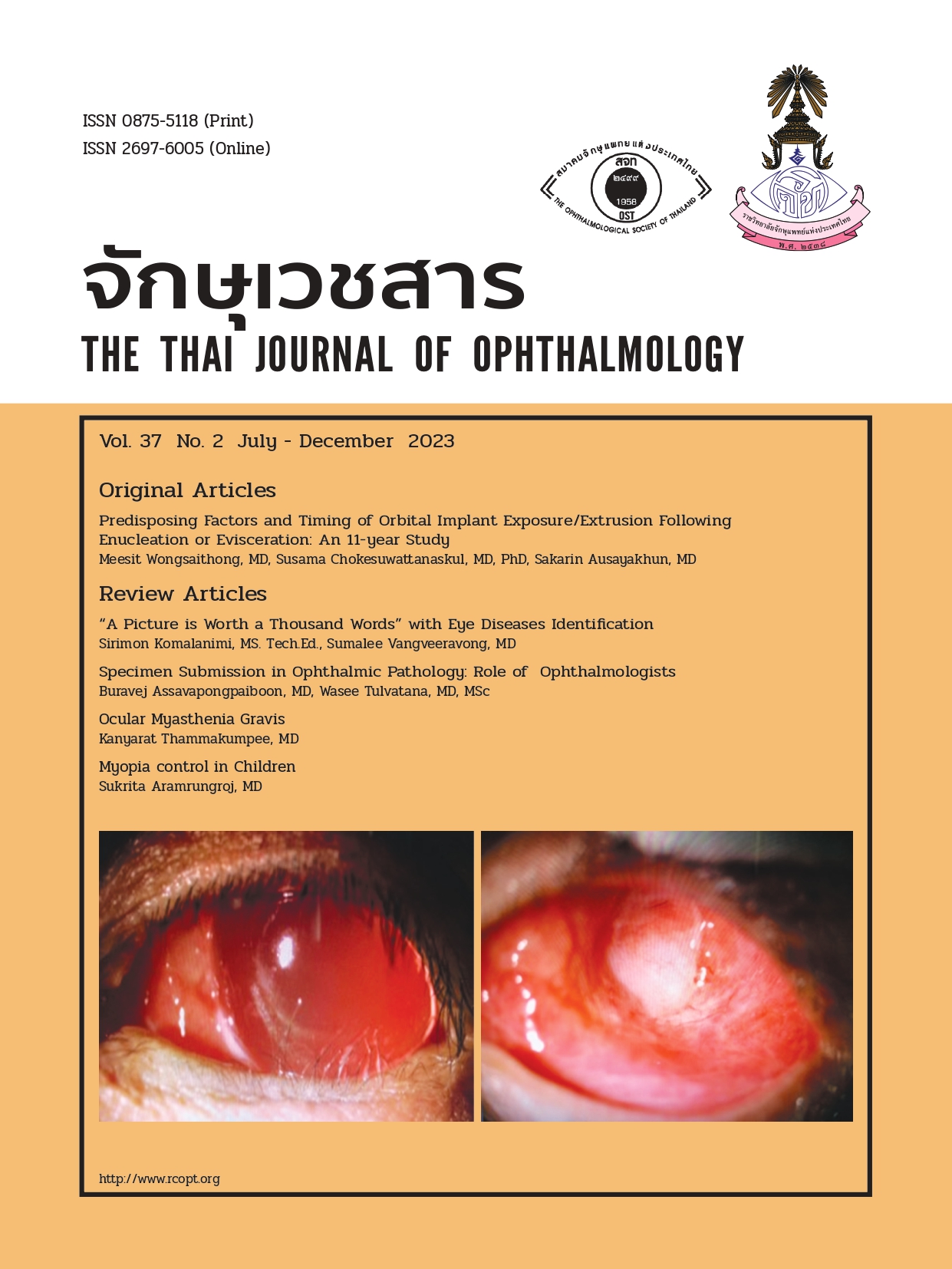หนึ่งภาพแทนพันคำ กับการให้รหัสโรคตา
คำสำคัญ:
รหัสโรค, รหัสโรคทางจักษุวิทยา, โรคตาบทคัดย่อ
“ภาพหนึ่งภาพมีคำหนึ่งพันคำ” เป็นสุภาษิตที่ใช้กันหลากหลายภาษา หมายความว่าภาพนิ่งภาพเดียวสามารถบรรยายหรือ
ถ่ายทอดความรู้สึกและสื่อสารสิ่งต่าง ๆได้มากพอ ๆ กับการที่เราใช้คำพูดเพื่ออธิบายเป็นพัน ๆ คำได้ในเวลาสั้น ๆ และพบว่าในการ
บันทึกผลการตรวจผู้ป่วยของแพทย์ในใบบันทึกเวชระเบียน แพทย์มักจะวาดรูปลักษณะความผิดปกติที่ตรวจพบหรือพยาธิสภาพของ
ผู้ป่วยที่มารับการตรวจรักษาลงในใบบันทึกการตรวจ เพื่อให้เห็นและเข้าใจง่าย สะดวกและรวดเร็ว ลดระยะเวลาการเขียนบรรยาย
รายละเอียด ในการตรวจการเจ็บป่วยที่ดวงตาก็เช่นกัน ถ้าเรานำภาพมาบรรยายถึงโรคตา ในภาพหนึ่งภาพที่แพทย์วาดลงในการตรวจ
รักษาแต่ละครั้ง อาจช่วยให้ผู้ลงรหัสโรคสามารถเข้าใจและลงรหัสโรคได้อย่างครบถ้วนและถูกต้อง เพราะส่วนใหญ่แพทย์อาจให้การ
วินิจฉัยโรคเพียงโรคเดียว เนื่องจากการให้รหัสโรคที่ถูกต้องครบถ้วน มีความสำคัญต่อข้อมูลของระบบสาธารณสุข องค์การอนามัย
โลกจึงได้กำหนดแนวทางการให้รหัสโรคของทุกประเทศในโลกไปในทิศทางเดียวกัน โดยจัดทำ The International Classification
of Diseases and Related Health Problems, 10th : ICD 10 เพื่อเป็นประโยชน์ในการติดตามข้อมูลและสถิติโรคทางงานวิจัย และ
สาธารณสุข ดังนั้น แพทย์ผู้ตรวจจึงต้องบันทึกข้อมูลให้ครบ เพื่อการลงรหัสโรคที่ถูกต้องและครบถ้วนเช่นกัน แต่ข้อจำกัดในเรื่องเวลา
การตรวจและจำนวนคนไข้ที่มากเกินเวลาการให้บริการการตรวจ อาจทำให้แพทย์ไม่สามารถเขียนหรือบรรยายรายละเอียดได้มากตาม
ต้องการ ลายมือแพทยท์อ่านยาก หรือ บางครั้งเป็นตัวย่อที่ผู้ให้รหัสโรคไม่เข้าใจ ภาพวาดทีแพทย์บันทึกอาจเป็นแนวทางในการให้รหัส
โรคตาได้ ซึ่งจะเป็นประโยชน์ต่อการวางรากฐานระบบสาธารณสุขของประเทศในอนาคต
เอกสารอ้างอิง
ปานทิพย์ สวัสดิ์มงคล, วันดี วันศรีสุธน. คำย่อสำหรับการให้รหัส ICD ผู้ป่วยนอก (Abbreviations for ICD coding in outpatient 2009). กรุงเทพฯ: เปเปอร์เมท (ประเทศไทย)จำกัด; 2551.
ปทุมมาศ เชี่ยวเชิงงาน, เพ็ญพร โฉมชัชวาล, ปัทมา สันติวงศ์เดชา. คู่มือกายวิภาคศาสตร์สำหรับ Coder (Anatomy For Coder). กรุงเทพฯ: บริษัทไชยเจริญการ
พิมพ์และบรรจุภัณฑ์ จำกัด; 2553.
วรรษา เปาอินทร์. การใช้รหัส ICD-10-TM ในระบบข้อมูลสุขภาพ. กรุงเทพฯ: รงพิมพ์องค์การรับส่งสินค้าและพัสดุภัณฑ์; 2547.
วรรษา เปาอินทร์. ความรู้พื้นฐานการใช้รหัสโรคและรหัสผ่าตัดตามระบบ ICD. กรุงเทพฯ: โรงพิมพ์องค์การรับส่ง
สินค้าและพัสดุภัณฑ์; 2548.
สำนักงานนโยบายและยุทธศาสตร์ สำนักปลัดกระทรวงสาธารณสุข กระทรวงสาธารณสุข. ICD-10-TM บัญชีจำแนกโรคระหว่างประเทศฉบับประเทศไทย (อังกฤษ-ไทย). เล่มที่ 1 ตารางการจัดกลุ่มโรค. กรุงเทพฯ: บริษัท ศรีเมืองการพิมพ์ จำกัด; 2559.
ดาวน์โหลด
เผยแพร่แล้ว
ฉบับ
ประเภทบทความ
สัญญาอนุญาต
ลิขสิทธิ์ (c) 2023 จักษุเวชสาร

อนุญาตภายใต้เงื่อนไข Creative Commons Attribution-NonCommercial-NoDerivatives 4.0 International License.
The Thai Journal of Ophthalmology (TJO) is a peer-reviewed, scientific journal published biannually for the Royal College of Ophthalmologists of Thailand. The objectives of the journal is to provide up to date scientific knowledge in the field of ophthalmology, provide ophthalmologists with continuing education, promote cooperation, and sharing of opinion among readers.
The copyright of the published article belongs to the Thai Journal of Ophthalmology. However the content, ideas and the opinions in the article are from the author(s). The editorial board does not have to agree with the authors’ ideas and opinions.
The authors or readers may contact the editorial board via email at admin@rcopt.org.


